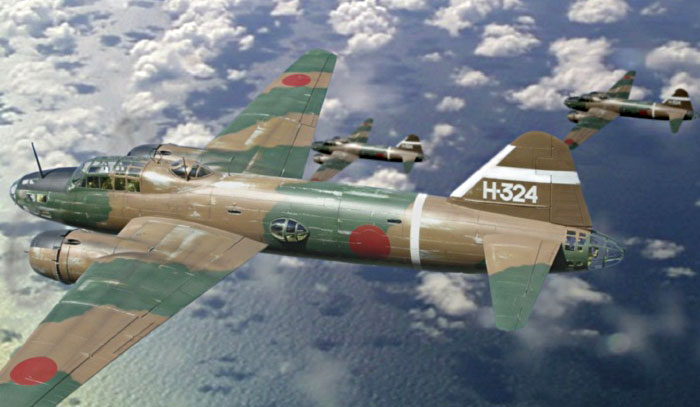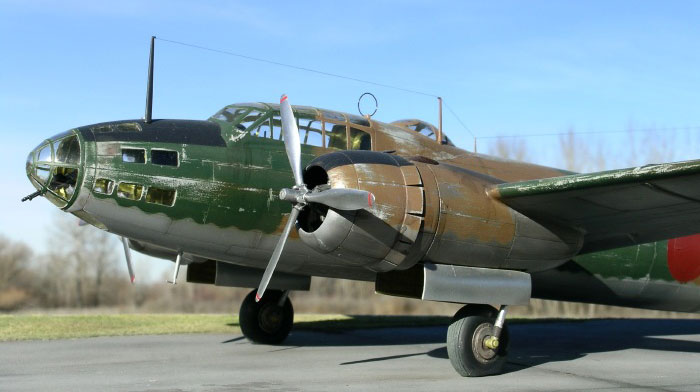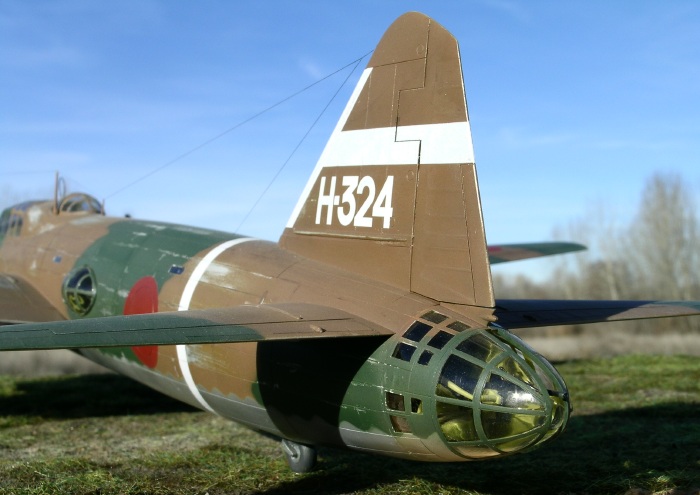|
Tamiya’s 1/48 scale
Mitsubishi G4M1
“Betty”
by
Ian Robertson
|
 |
|
Mitsubishi G4M1 “Betty” |

Tamiya's
1/48 scale Betty is available online from Squadron.com
During WWII the Japanese were in desperate need of a bomber with
extremely long range that could support naval operations in the Pacific.
Enter the Mitsubishi G4M1 “Betty”, a cigar-shaped twin-engine bomber
that traded off defensive armor and self-sealing fuel tanks for extended
fuel capacity and a propensity to burn when hit by enemy fire.

At the hands of US gunners the Betty soon earned the nickname
“one-shot lighter” owing to its incendiary qualities. Nevertheless, the
G4M1 was a mainstay of the Imperial Japanese Navy Air Force throughout
much of the war.
Tamiya's
1/48 scale Betty kit
|
Tamiya’s 1/48 scale Betty is a real monster, with a wingspan of 52cm
(~20 inches) and a length of 42cm (~17 inches). But don’t let the large
size deter you. This model is a fantastic build and makes a very
impressive display when complete, especially next to those diminutive
single engine fighters.
The kit features finely recessed panel lines in light grey plastic,
excellent clear parts, and a wealth of detail. The only additions I made
were hollow metal exhausts from Moskit, True Details weighted resin
tires, and a loop antenna made from wire. My particular model represents
H-324, a G4M1 that flew from Saipan in July 1942. A color profile of
this aircraft is featured in Osprey’s “Mitsubishi Type 1 Rikko “Betty”
Units of World War 2”, an excellent reference for the Betty.

I built this model several years ago so the details of construction are
a bit foggy. Suffice it to say I encountered no major difficulties. The
addition of hollow metal exhausts was a great enhancement to the kit
since these exhausts are very prominent.
I painted the interior yellowish green using Polly Scale’s
Weyerhaeuser green as a substitute for Tamiya’s odd suggestion of RLM02
grey in their instructions.
My particular aircraft featured a worn two-tone camouflage scheme of
brown and green over natural metal. I began by priming the model with
Tamiya light grey surface primer and then polishing it to a smooth sheen
using Micromesh cloths. The white bands on the fuselage and tail were
painted and masked until all other painting was complete. I then painted
the entire aircraft with various shades of Alclad II metalizers. The
fabric control surfaces on the underside were painted Japanese Army Grey
using Tamiya acrylic (XF-14).

 The
upper surfaces of the model were painted with Polly Scale acrylics. The
brown, if I recall correctly, was a mixture of Dark Earth and Japanese
red-brown, while the green was a lightened version of IJNAF green. Paper
masks were used to create a hard edge between the colors. The
upper surfaces of the model were painted with Polly Scale acrylics. The
brown, if I recall correctly, was a mixture of Dark Earth and Japanese
red-brown, while the green was a lightened version of IJNAF green. Paper
masks were used to create a hard edge between the colors.
Once the basic camouflage was applied I used fine grain sandpaper to
wear away areas of the finish, particularly on the nose, engine cowls,
wing roots and upper fuselage. I used photographs in the Osprey book to
determine an appropriate amount of wear for my model.
Washes of dark reddish brown were also used to create variation in
the surface colors.
Once the camouflage had been weathered, I used circular masks to paint
the hinomarus on the wings and fuselage. I wanted the hinomarus to be in
relatively good condition, albeit slightly faded, since these symbols
were factory applied and typically suffered less weathering that the
camouflage. A coat of light grey was sprayed as an undercoat of the red
to ensure even coverage.
The only decals used on the model were the tail codes.
This model is one of the largest in my collection, and as such stands
out among all the single engine fighters. For fans of WWII Japanese
aircraft, this model should not be passed up.
Photographs
Images were taken outdoors with a Nikon Coolpix 5400 digital camera.
The “unsharp mask” tool of Adobe Photoshop was used to restore some of
the clarity and crispness lost during image compression. The composite
image was designed in layers in Photoshop.
Click on the thumbnails
below to view larger images:
Mitsubishi Type 1 Rikko
Betty Units of World War 2
Combat Aircraft 22 |
|
|
|
|
Author: Osamu Tagaya
Illustrator: Mark Styling
US Price: $19.95
UK Price: £12.99
Publisher:
Osprey Publishing
Publish Date:
April 25, 2001
Details: 112 pages; ISBN: 184176082X |
|
|
Model, Images and Text Copyright ©
2005 by Ian Robertson
Page Created 01 February, 2005
Last Updated 01 February, 2005
Back to HyperScale
Main Page
|
Home
| What's New |
Features |
Gallery |
Reviews |
Reference |
Forum |
Search